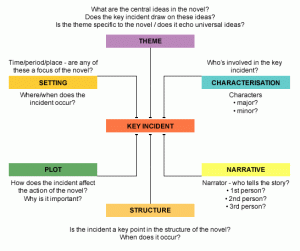The idea of ‘plot’ can refer to various narrative techniques and literary devices: setting, time, point of view, focalisation, characterisation, sequencing, genre, etc. I will come to all of these in the course of ‘the year of writing my novel’, what I am interested in today is creating a bare bones list of ideas that will form the basic plot of my novel.
I already have a short story written that will form the spark of my novel, but it is in building sub-stories, or subplots, in the fleshing out of the original story, that I am hoping the novel might grow.
Of course there are any number of plot proformas you could use, like this one from BBC: Higher Bitesize English:
Here is my bare bones plot, based on the structure I found when researching plot in my previous post from 23/01/13 Plotting the course:
Motivation: Annabella wants to belong
Plot structure: She is unaware of her background. She is raised by her grandmother. She goes to live and work in the castle. She falls in love. Suspicion is cast upon her.
Outcome: She flees the town.
Annabella’s story: Her background.
Subplot 1: The story of the princess.
Subplot 2: The story of Gorge.
Subplot 3: The socio-political background of the era.
Subplot 4: Witches, vampires and murders. (Don’t panic – it will not be another vampire book – but vampires were a part of the historical era in which the story is set. And if you like vampire books, there might be enough here to keep you interested!)
As an aside discussion, each time I come to post, I wonder how much I should include. I have done a lot initial research for my novel (remember it will be historical fiction) and have quite a bit of plot detail in certain parts of the above, and yet I also want to hold some things back, I don’t want to give away the whole story, but I want to include reader in the journey, and I want my blog readers to get enough information that they will join me in attempting to write a novel.





I think how much you include when beginning to set down your plot depends on which genre you write in and the writer themselves to be honest. For something like historical fiction, a more detailed outline would be better because you have to make sure all the facts are right. There’s always someone who likes to point out historical innacuracies!
If it’s something like epic fantasy, again, a detailed outline would be better, especially if you’re worldbuilding rather than setting it in our world. Saying that, there’s a lot of people who jot down the barest bones they can get away with, or even nothing at all, and still produce a brilliant story.
I personally only write down things that I really need to keep in mind like details of the cities I set my novels in because when I get too detailed, I get bogged down thanks to constantly cross-checking whether I’ve got things right or if what I’m writing is ‘in character’.
I have to admit, I am more than a little afraid of historical inaccuracies! Especially as there is a language barrier to contend with, and the evidence itself suggests a lack of consitency. Much of my planning has been linked to historical fact.
Bringing in elements of fantasty has brought an added level of plotting complexity. I have found if I am writing segments that haven’t been plotted, I either don’t give enough information or I give away everything – there’s no foreshadowing! But these bits of writing feel more ‘inspired’ somehow – I guess it’s a sense of ‘free’ writing.
I think you are right though, it seems to be a balance of plotting and pantsing that is needed.
It is great to hear how other writers work!